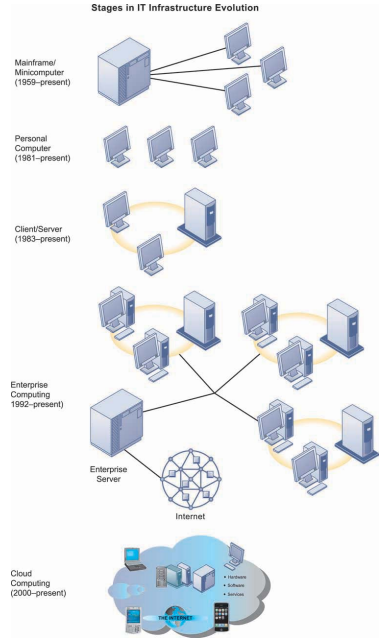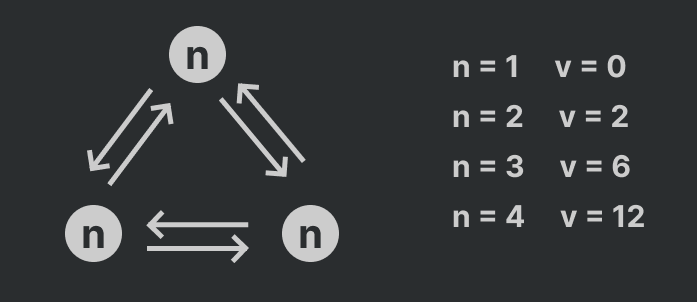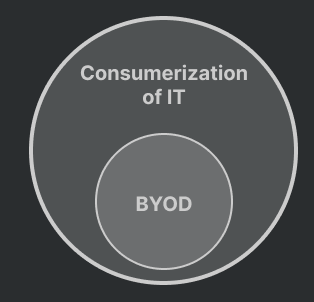05 IT Infrastructure and Emerging Technologies
in Notes / Othermajors / Managementinformationsystems
- 1: IT Infrastructure
- 2: Infrastructure Components
- 3: Contemporary Hardware Platform Trends
- 기말고사 범위 시작
- 4: Contemporary Hardware Platform Trends
- 5: Management Issues
1: IT Infrastructure
Defining IT Infrastructure
— Technical Part (기술)
- Computing Platforms
- Telecommunications
- Data Management
- Application software services
- Physical facilities : 시설 관리 (FM: Facility Management)
— Planning Part (기획)
- IT management services
- IT standards services
- IT education
- IT research and development : R&D 연구개발
Evolution of IT Infrastructure
History of Hardware

- General-Purpose Mainframe and Minicomputer Era (1959~)
CPU(연산장치),Memory(기억장치)는 중앙에만 있고 컴퓨터에는 키보드와 마우스만
- Personal Computer Era (1981~) : 각자
CPU+Memory - Client/Server Era (1983~), aka C/S
- 핵심: NETWORK (선이 없음)
- 중앙 DB 사용해서 모두 같은 data로 사용 (
req,res, aka \(RR\) \(system\)) - multitiered (N-tier, 다계층) client/server architecture
- 순서:
- 고객이 요청 \(\rightarrow\) Web Server이 user에게
HTML파일들을 보여준다 (마당쇠 역할) \(\rightarrow\) 고객의 요청 Web Application Service에게req\(\rightarrow\) Web Application Service가res돌려준다
- Enterprise Computing Era (1992~): 기업 컴퓨팅 시대
- C/S와의 차이점: INTERNET (type of network)
- Transmission Control Protocol / Internet Protocol (TCP/IP)
- Cloud and Mobile Computing Era (2000~)
- General Purpose (범용)
- Single/ Specific Purpose: 1950s 전에는 주로 컴퓨터를 특정 목적으로 만들어 사용함
- Computing Resource 사용하는 기법이 바뀐것
- Cloud Computing : provides access to shared pool of computing resources
- Mobile: \(mobility\) (portability) + \(connectivity\)
- \(XXX\) Computing Era: 여기 뭘 끼워넣을 것인가?
- 용어싸움…“Smart”같은거 (한국에서만 좋아하는) 넣어도 될듯?
Technology Drivers of Infrastructure Evolution
- IT의 변화를 가져온 기능적 {factors, 요인, 동(动)인}
1. Moore’s Law and Microprocessing Power
Moore's Law : the power of CPU doubles every 18 months
예언보다는
Intel의포부이자 비전이다TMI:
`Intel`의 공동창업자: Gordan Moore + Robert Noisse (Silicon Valley에 큰 기여를 함) -
`Moore-Noisse` 전자 -> `Intel` (Integrated Electronics)
-
microprocessors (CPU) utilized
Nanotechnology
2. The Law of Mass Digital Storage
- 저장장치의 발전 \(\rightarrow\) \(\approx\) doubles every year
Memory Size (MIDTERM)
- yotta \(\)
- zetta \(\)
- exa \(\)
- peta \(\)
- tera \(T\)
- giga \(G\)
- mega \(M\)
- kilo \(K\)
- :–:
- milli \(m\)
- micro \(\mu\)
- nano \(n\)
- picco \(p\)
- femto \(f\)
- atto \(a\)
3. Metcalfe’s Law and Network Economics
aka Network Effect
Robert Metcalfe : ethernet LAN 창시자
Value_of_Ethernet = # of connections
 \[\begin{equation} v=\begin{cases} n(n-1), & \text{if both ways}.\\ \frac{n(n-1)}{2}, & \text{if one way}. \end{cases} \end{equation}\]
\[\begin{equation} v=\begin{cases} n(n-1), & \text{if both ways}.\\ \frac{n(n-1)}{2}, & \text{if one way}. \end{cases} \end{equation}\]
\(n \rightarrow \infty\) \(\Rightarrow\) \(v\propto n^2\) 에 비례 \(\Rightarrow\) 한명의 참여자가 엄청난 차이를 만듦
4. Declining Communications Costs and the Internet
- 통신비 절감!
5. Standards and Network Effects
- Some important standards in Computing
| Standard | Explanation |
|---|---|
| ASCII (1958) | American Standard Code for Information Interchange, characters standardized to binary numbers to exchange data |
| COBOL (1959) | Programming Language |
| Unix (1969-75) | Mainframe에 깔아쓰던 OS, cmd |
| TCP/IP (1974) | Transmission Control Protocol/Internet Protocol |
| Ethernet (1973) | LAN의 표준 |
| IBM/Microsoft/Intel Personal Computer | The standard Wintel (windows+intel) design |
| World Wide Web (1989–1993) | Standards for storing, retrieving, formatting, and displaying information as a worldwide |
Service Standard
LAN Ethernet Internet TCP/IP WWW HTTP
2: Infrastructure Components
- Computer Hardware Platforms
IBM(International Business Machines) chips, AMD, Intel- Oracle Sun (Java)…?
- Operating System Platforms
LINUX(open source ofUnix) : 한때 엄청난 점유율을 자랑함- Chrome OS
- Android
- Enterprise Software Applications
- Data Management and Storage
- Networking/Telecomunications Platforms
- Cisco (router)
- AT&T (\(\approx\) KT), Verizon (\(\approx\) SK)
- Internet Platforms
- Web hosting service: maintains
- large Web server,
- series of servers
- space for fee-paying subscribers
- Consulting and System Integration Services
- \(SI\): System Integration
- Legacy System: 옛날꺼를 착하게 말한 것 (곧 대체될 시스템)
3: Contemporary Hardware Platform Trends
- The Mobile Digital Platform
- Consumerization of IT and BYOD (IT의 소비자화)
- BYOD: Bring your down device (\(\subset\) of Consumerization of IT)

- MDM (Mobile Device Management) : (본인)기기 회사용으로 등록
- BYOD: Bring your down device (\(\subset\) of Consumerization of IT)
- Quantum Computing (양자컴퓨팅)
- very fast,
- Superposition (qubit)
- Entransformant (??)
- hacking방법:
bruteforce로dictionary attack(dictionary안에 있는 모든 단어를 PW에 집어넣어봄)
- hacking방법:
- Virtualization (가상화): 없는 하드웨어를 있는 것처럼 사용
- Virtual Machines (VMware같은)
- SD\(X\) <- hardware
SDS:
physical view logical view C Drive, D Drive C+D
- Cloud Computing
- \(X\)aaS : \(X\) as a service
- 3 different services of Cloud Computing (most typical)
- IaaS : Infrastructure aaS \(\approx\) HW. Disk 저장공간 빌려쓰기
-
Google drive
-
- SaaS : Software aaS
Google docs - PaaS : Platform aaS
collab - 단점: 보안문제 (개인정보 유출)
- private, public cloud
- public cloud (공개형)
Google, Microsoft, Naver - private cloud (사설형)
- hybrid (public+private): 어떤건 내가 가지고 보고 어떤건 맡김
- 조금이라도 분담 or 공동 \(\Rightarrow\) hybrid
- multicloud: 여기저기 분산 (안정성, 비용 측면에서 굳)
-
multivendor: 여러공급사
-
- public cloud (공개형)
- temp server (cache 역할)
Netflix - efficient, traffic 방지됨
- 최근 논란: 국내 Netflix의 이런한 서버비용을 누가 대야 하는가
Green Computing : 전기 아끼기 (AI한테 한번 물어봐도 500mL의 물? 물값?이 사라진다고 한다)
High-Performance and Power-Saving Processors
- multicore processor: 따로 쓰는 것 보다 (CPU3개) 같이 쓰는게 효율이 좋다 \(\Rightarrow\) also green IT
기말고사 범위 시작
4: Contemporary Hardware Platform Trends
Linux and Open Source Software
- Open Source Software (OSS) examples:
- OS: Linux, Unix
- Web server: Apache HTTP
- Web browser: Mozilla Firefox
- Office Suite :
- Apache OpenOffice
- MS Office \(\longrightarrow\) OpenOffice
- Word \(\longrightarrow\) Writer
- Excel \(\longrightarrow\) Calc
- PPT \(\longrightarrow\) Impress
- Access \(\longrightarrow\) Base
- Libre Office
- Web broswer TMIs:
IE: 前 Mirosoft (Windows) default browserFF: by MozillaChrome: Free but not open sourceChromium: open source web browser (supported by Google)- open source \(\Rightarrow\) 새로운 feature 빨리 나온다 (Chrome의 test platform)
- 좋은 기능 있으면 Google에 보낸다 \(\Rightarrow\) Chrome으로 다시 패키지화
- Versions: \(Dev \longrightarrow Beta \longrightarrow Stable\)
- Chrome, Whale (Naver), Edge (Bing Serach Engine + ChatGPT) 다 Chromium의 \(+ \alpha\)
- AI TMI: 인공지능 (ChatGPT, Bard)를 잘 사용하려면
prompt(명령어)를 잘 입력 해야함 - Search Engine TMI: 교내에서만 찾기 \(\longrightarrow\) XXX site: korea.ac.kr 로 검색
- 정보를 줄여서 효용성 높이기
Software for the Web: Java, HTML, and HTML5
- JAVA: OS independent, OOP (객체지향형)
- Java Virtual Machine: 실제 하드웨어나 OS가 아닌, 가상의 일종의 API이다
- API: Application Programming Interface
HTML이 쭉 발전해서HTML5가 됨HTML5: 주로 멀티미디어 파일들을 홈페이지에 쉽게 내장가능하게 기능 추가됨- Hypertext Markup Language : 홈페이지 만드는데 사용
- 위지위그 방식: 내가 보는대로 사람들이 보는 (like MS Word)
JavaScript: interpreter, 한줄 한줄 해석 (not OOP)HTML5에 적용해서 dynamic 한 처리를 가능케 해줌
Web Services and Service-Oriented Architecture
- Web Services: 인터넷에 연결되어 있는 컴퓨터들이 데이터를 교환할 때 _인간의 개입 없이 목적 달성 가능_하게 만들어주는 시스템 (우리가 생각하는 웹 서비스 의미가 아닌)
- XML (Extensible Markup Language): tag로 요소들 specifiy 가능
- can perform presentation, communication, and storage of data
- ppt도 pptx,
- SOA (Service Oriented Architecture, 쏘아) : 근데 욪므 다 이렇게 해서 이 명칭 잘 안씀
- SW outsourcing: 외부인력이 개발 또는 유지보수
- SLA (Service Level Agreement): 계약서의 한 종류
- 서비스 제공 범위 및 책임 정의
n초만에 나오기...등등 - 적절하게 사용 필요, 신중하게 결정하기
- 서비스 제공 범위 및 책임 정의
- Mashup : (좋은 기능들을) 섞어두기, 일종의 Hybrid App
- \(\rightarrow\) API가 중요하다
5: Management Issues
- Total Cost of Ownership (TCO) : 총소유비용
- 구매 뿐만 아니라 유지하는데 필요한 비용까지 계산
- MS 에서
TCO 관점 많이 강조
- Review Questions
